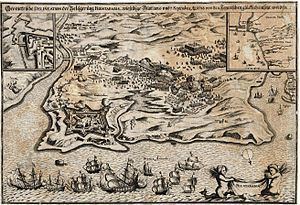4,000 dead or wounded2,000 captured Unknown | ||
 | ||
18,000 infantry and 2,000 cavalry20–30 warships7,000 sailors 1,300 men(Hondarribia)15,000 infantry and 500 cavalry(Spanish Relief Army) Period June 1638 – September 1638 Similar Battle of Les Avins, Battle of Honnecourt, Battle of Wolgast, Battle of Oldendorf, Battle of Mingolsheim | ||
The Siege of Fuenterrabía of 1638 took place in June – September, 1638, between Spain and France during the Thirty Years' War and the Franco-Spanish War (1635-1659).
The French army commanded by Henri de Bourbon, Prince of Condé and Henri d'Escoubleau de Sourdis composed of 27,000 men and several warships besieged the city for two months, firing 16,000 shells into the walled city, leaving only 300 survivors, most of them women and children. The city was virtually destroyed, but nevertheless did not surrender.
On 7 September, the Spanish army led by Juan Alfonso Enríquez de Cabrera, 9th Admiral of Castile, relieved the city and defeated the French forces. The Spanish soldiers were successful, and the raising of the siege is celebrated annually on 8 September in a parade, known as Alarde.
After the French disaster of Fuenterrabía (Hondarribia), Henri d'Escoubleau de Sourdis attempted to blame the defeat on one of his generals, Bernard de La Valette, Duke d'Épernon, who had refused to lead the attack, believing that it would fail.
For the successful resistance, the city received the title of «Muy noble, muy leal, muy valerosa y muy siempre fiel».
